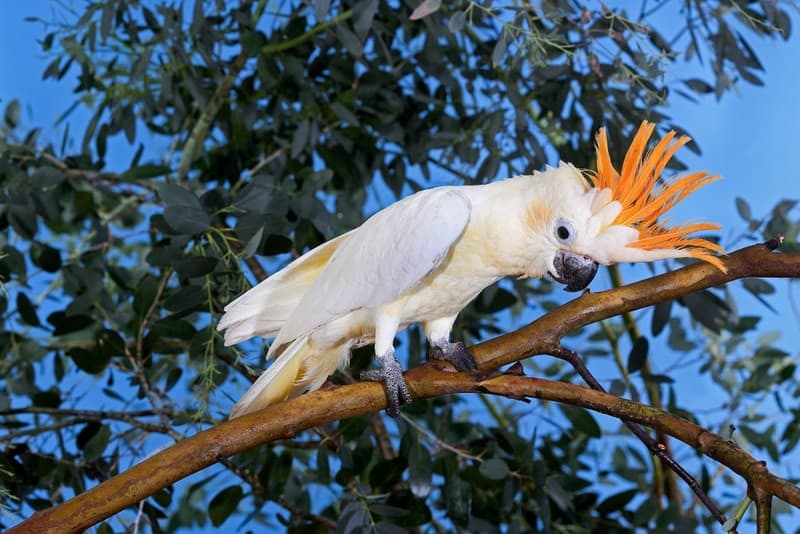
The Citron-crested Cockatoo really stands out with the orange feathering in its crest and cheeks! It is the most striking of the six subspecies of the Lesser Sulphur-crested Cockatoos!
Sometimes referred to as the “apartment-sized cockatoo”, the Citron-crested Cockatoo is a smaller cockatoo (though it is a bit larger than other Lesser Sulpher-crested Cockatoos). It is a pretty bird with graceful movements and a delicate appearance.
This is Initially a rather shy bird, but once it is used to being around people the Citron-crested Cockatoo will love attention and can be very affectionate. It can also be a very playful comedian! When it gets excited it will lift up its crest like an Indian headdress, bob up and down, and even dance.
Though they are generally very docile, they can be a bit more animated than the other Lesser Sulphur-crested Cockatoos. They can learn to speak and are easy to teach all kinds of tricks. They are also one of the easiest cockatoos to breed.
Like cockatoos in general, they are a very loving type of bird. Affection is readily accepted and returned in kind. They are a pet that not only appreciates interaction but requires it and needs a lot of attention from their owners. Buy a cockatoo only if you can spend a lot of time with it.
To learn more about Cockatoos and their needs visit:
Guide to a Happy, Healthy Cockatoo
- Kingdom: Animalia
- Phylum: Chordata
- Class: Aves
- Order: Psittaciformes
- Family: Cacatuidae
- Genus: Cacatua
- Species: sulphurea citrinocristata
Scientific Name:
Cacatua sulphurea citrinocristata
Distribution:
This bird is native to Sumba, and Indonesian island. They inhabit open woodlands, the edges of forests, and cultivated wheat fields.
Description:
The Citron-crested Cockatoo has white plummage with an orange crest on the top of the head and on the cheeks, rather than yellow like the other Lesser Sulpher-crested Cockatoos. The rest of their coloring is the same as the others with yellows on the undersides of their wings and tail, but they are a bit larger. They can learn to talk, as can most cockatoos and are easy to teach all kinds of tricks. Mature birds are about 35 cm (14 inches) in length.
A younger bird will be similar to the adults but have pale gray eyes. The beak will also be lighter for a short period of time, until about 7 months.
Care and feeding:
A roomy cage is required unless the bird is to be let out for extended periods. Many birds can spend most of their time on a play pen or parrot perch. These birds are good fliers and avid chewers. It is good to provide them with lots of natural branches, chunks of untreated wood, or even whole coconuts to keep them busy and content.
In the wild they eat seeds, berries, nuts, fruits and probably vegetable matter. They eat a variety of seeds, nuts, fruits, and commercial pellets, as well as the same nutritional foods humans eat.
See About Cockatoos: Housing and About Cockatoos: Care and Feeding for more information.
 “Precious” Citron-crested Cockatoo Photo Courtesy: Bruce “The Bird Guy” McGonigal
“Precious” Citron-crested Cockatoo Photo Courtesy: Bruce “The Bird Guy” McGonigal
“Precious is very gentle, but likes to pull hairs out of your head while taking a photo. She loves to be around kids. She knows how to give shaka with her claw and says “Hi”. Shaka,- pronounced “shah-kahh”, means excellent or great in Hawaiian. Frequently it is used as a handsignal throughout the islands. It can also mean awesome, hang-loose or Aloha. Precious was born in 2002″… Bruce McGonigal
Social Behaviors:
In the wild Cockatoos are friendly and peaceful. They live in pairs or small flocks though sometimes they will gather in very large flocks to feed.
They enjoy and require a lot of affection and attention. It is often recommended that they be kept in pairs so they will keep each other company. This can help to reduce the amount of time you will have to devote to an individual bird.
Breeding/Reproduction:
See About Cockatoos: Breeding for Cockatoo breeding information.
Sexual differences:
Hard to tell the sex of young birds. As they get older the iris of the females’ eyes will develop a reddish color, the males’ eyes will be dark brown to black.
Potential Problems:
Cockatoos can be quite loud screechers. This behavior can be reduced by giving attention and proper surroundings. Also, since they are prone to chewing, if they are not given enough attention they will chew their own feathers.
See About Cockatoos: Potential Problems for information on illnesses.
Availability:
These birds, though not as common as the Lesser Sulpher-crested Cockatoo, are occasionally available.
Activities:
Loves to climb and play and chew. Provide lots of toys.
Featured Image Credit: slowmotiongli Shutterstock
